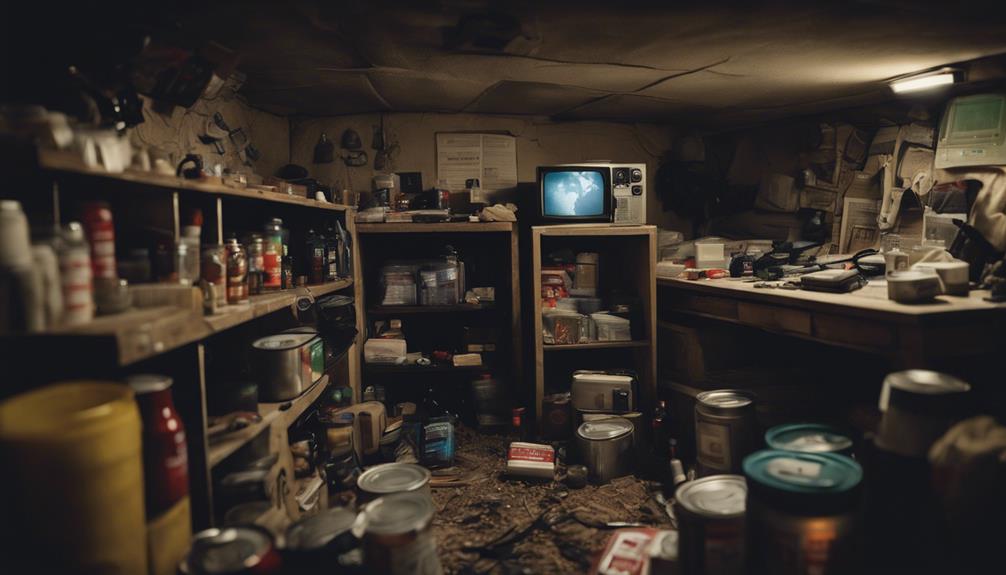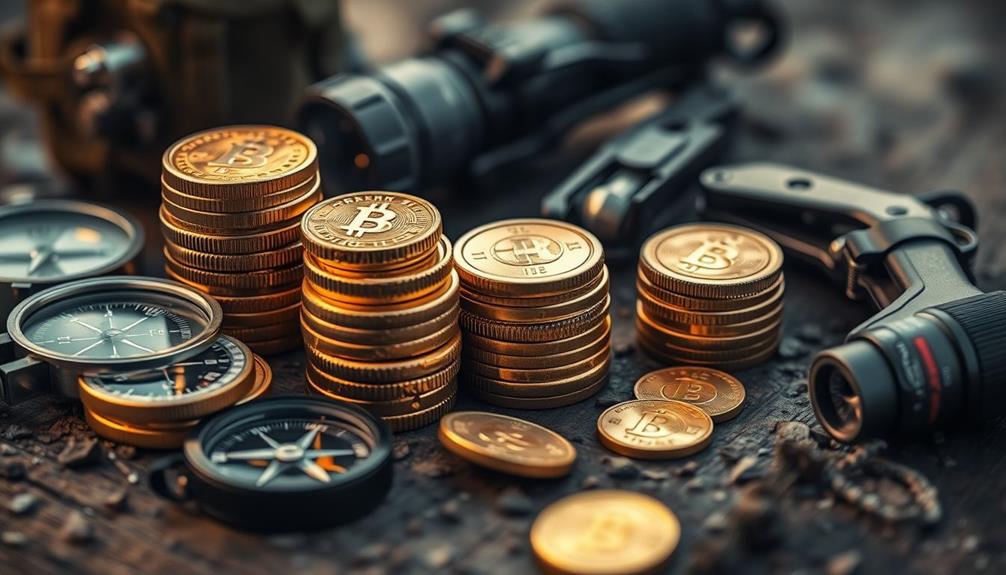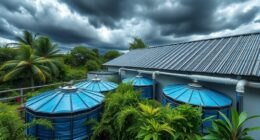To survive in the wilderness, you need vital gear. Start with a quality knife for cutting and carving. A reliable lighter's essential for starting fires and keeping warm. Don't forget signaling tools like a whistle or signal mirror, which can draw attention if you're lost. Stay hydrated with a collapsible water container and purification tablets. Pack a waterproof jacket and an insulated sleeping bag to protect against the elements. Finally, carry a map and compass for navigation. With the right equipment, you can face the wild with confidence, so keep exploring to uncover even more survival essentials.
Key Takeaways
- A quality knife is crucial for cutting, carving, and preparing food in survival situations.
- A reliable lighter is essential for starting fires for warmth, cooking, and signaling for help.
- Adequate hydration is vital; carry a reservoir and purification tablets to ensure safe drinking water.
- Emergency signaling equipment, such as a whistle and signal mirror, can attract rescuers in distress.
Key Survival Tools
When you're out in the wilderness, having the right survival tools can mean the difference between life and death.
A quality knife is essential; its durability and multiple uses—like cutting and carving—make it indispensable.
You'll also want a lighter for starting fires, which are vital for warmth and signaling.
An emergency blanket keeps you warm at night and can be dried during the day.
Don't forget signaling equipment like a whistle or mirror to attract attention if you need help.
Finally, cordage or rope can assist with building shelters or securing your gear.
Pack these key survival tools, and you'll be much better prepared for whatever challenges nature throws your way.
Water Procurement Essentials
Accessing clean water is essential for survival in the wilderness, so having effective water procurement essentials is a top priority. Without proper hydration, your endurance and decision-making abilities can quickly diminish.
Here are three important items to include in your gear:
- Reservoir/Hydro Flask: This can hold 3 to 5 liters of water, ensuring you have enough for emergencies and long treks.
- Potable Aqua Iodine Tablets: Lightweight and compact, these tablets purify water, making it safe to drink, even from questionable sources.
- Collapsible Water Container: Easy to pack, this container allows you to gather and transport water efficiently from streams or other sources.
Navigation and Communication Gear

Having clean water is only part of wilderness survival; knowing how to navigate and communicate effectively can make all the difference in finding help or returning to safety. Equip yourself with essential navigation tools like a reliable compass and a detailed map. While cell phones can be handy, remember they may lose signal in remote areas. For emergency communication, pack signaling equipment like a whistle or a signal mirror.
Here's a quick comparison of navigation and communication gear:
| Gear Type | Key Features |
|---|---|
| Compass | Essential for accurate navigation |
| Cell Phone | Useful, but signal may vary |
| Signal Mirror | Visible from long distances |
| Whistle | Recognized sound for attracting help |
| Map | Best used alongside a compass |
Clothing and Shelter Needs
Proper clothing and shelter are essential for staying warm and dry in the unpredictable conditions of the wilderness. Choosing the right gear can make all the difference in your survival experience.
Here are three key items to contemplate:
- Change of Clothing: Always pack extra clothes made of synthetic materials. They'll keep you warmer and dry quicker than cotton, which retains moisture and can lead to fatigue.
- Emergency Blanket: Lightweight and compact, this can be a lifesaver. It provides warmth and can be used as shelter if needed.
- Cordage or Rope: Parachute cord is versatile for building shelter, securing gear, and making repairs. It's a must-have for any survival situation.
Signaling and Safety Equipment

Signaling and safety equipment are essential for attracting attention and guaranteeing your survival in the wilderness.
A signal mirror can reflect sunlight over long distances, making it a powerful tool for drawing attention. Whistles are lightweight and produce a loud sound, easily recognized by rescuers. Don't forget to pack a lighter, which can create smoke signals, providing visual cues of your location.
A fully charged cell phone can also be a lifeline, but don't rely solely on it since reception varies. Carrying a basic first aid kit guarantees you're prepared for injuries.
Always have cordage handy; it can be used to secure gear or create makeshift shelters. Together, these items enhance your chances of being found and staying safe.
Frequently Asked Questions
How Do I Choose the Right Emergency Blanket for My Needs?
To choose the right emergency blanket, consider its size, weight, and insulation properties. Look for a durable, compact design that maintains warmth and can be easily packed. Comfort and functionality should be your priorities.
Can I Use My Phone for Navigation Without Cell Service?
Yes, you can use your phone for navigation without cell service by downloading offline maps beforehand. Just make sure you've got a reliable app, and consider using a compass as a backup for accuracy.
What Are the Best Techniques for Maintaining My Knife?
You might not realize how often you reach for your knife until it's dull. To maintain it, regularly sharpen the blade, clean it after use, and store it properly. A well-cared knife enhances your efficiency.
How Should I Pack My Survival Gear for Easy Access?
When packing your survival gear, prioritize items you'll need first. Keep essentials like your lighter, knife, and water purification tablets easily accessible. Use compartments to organize, ensuring quick retrieval during emergencies or urgent situations.
What Should I Do if I Run Out of Potable Aqua Tablets?
If you find yourself in a desert, parched and desperate, try boiling water over a fire to purify it. Alternatively, filter through cloth or sand to remove debris, then make sure it's safe to drink.
Conclusion
As you prepare for your wilderness adventure, think of your gear as the sturdy roots of a tree, anchoring you in uncertain terrain. Essential prepper gear includes items such as a reliable backpack, waterproof and insulated clothing, a high-quality tent, and a durable water filtration system. Just as the roots of a tree provide stability and support, this gear will ensure that you are well-equipped to handle whatever challenges the wilderness may present. With the right gear, you can focus on embracing the adventure and creating lasting memories, knowing that you are prepared for whatever may come your way.
Each essential item you pack not only enhances your safety but also allows you to embrace the wild with confidence.
By equipping yourself with the right tools, you're not just surviving; you're thriving in nature's embrace.
So head out, stay prepared, and let the adventure unfold, knowing you're ready for whatever comes your way.










